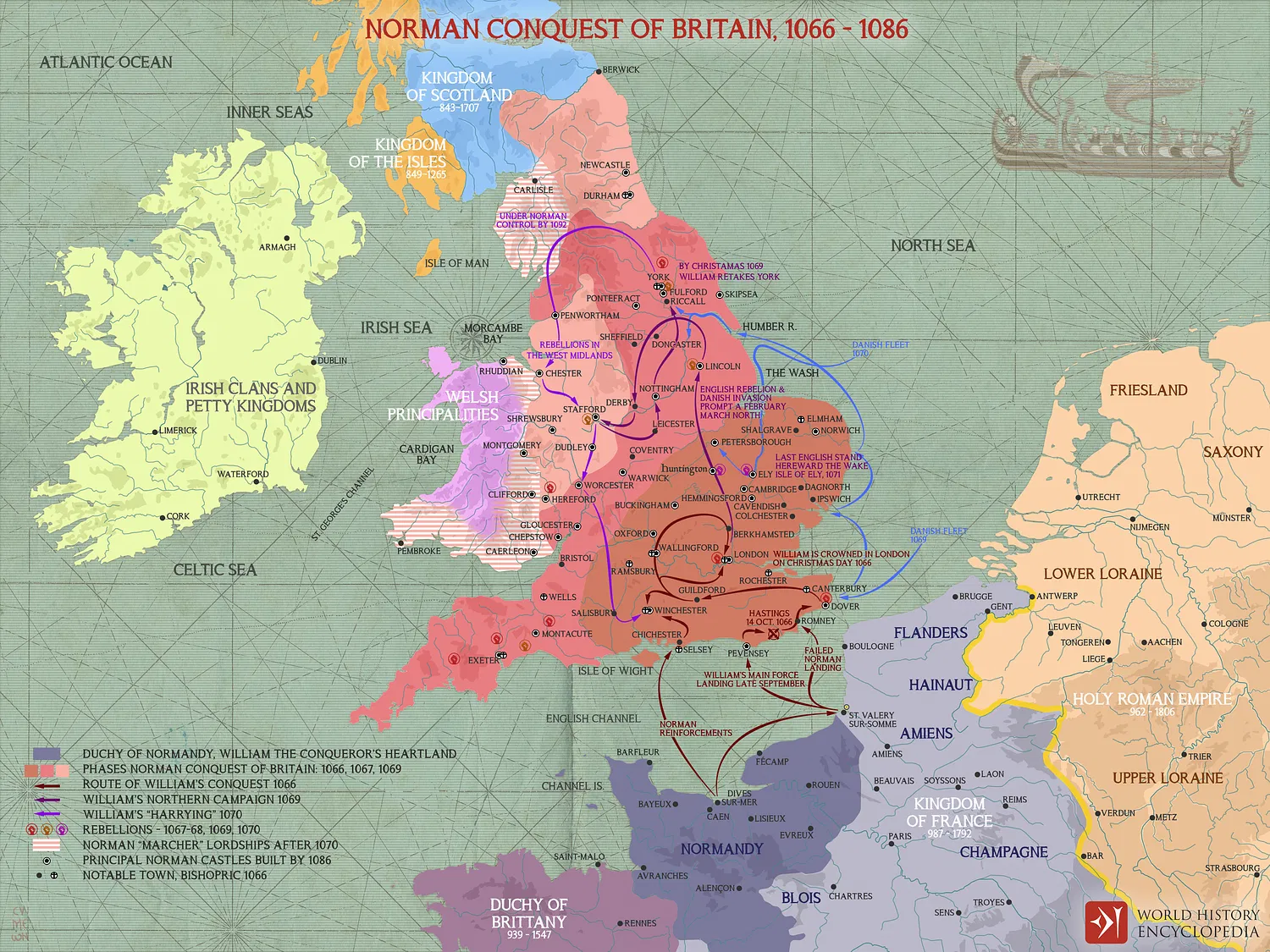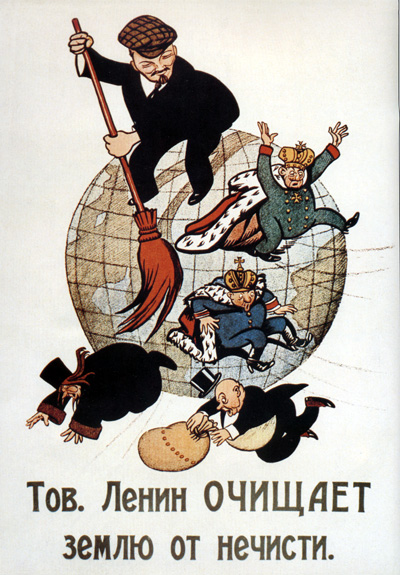The Norman Conquest of England (1066-71) was led by William the Conqueror who defeated King Harold II at the Battle of Hastings in 1066. The Anglo-Saxon elite lost power as William redistributed land to his fellow Normans. Crowned William I of England (r. 1066-1087) on Christmas Day, the new order would take five years to fully control England.
Following Harold’s death at Hastings, William was obliged to see off several major invasions and rebellions, but once established, Norman England would witness profound changes in all areas of society. These changes included a restructuring of the Church, innovations in military and religious architecture, the evolution of the English language, the spread of feudalism and a much greater contact with continental Europe, especially France.
The Claims On the English Crown
In 1066 when the Norman invasion began, the king of England was Harold II, formerly Harold Godwinson, Earl of Wessex. William, Duke of Normandy (r. from 1035), centred his claim on his relationship with Harold's predecessor, Edward the Confessor (r. 1042-1066) who was a distant relation. William also claimed that the English king, without children of his own, had once promised the Norman he would be Edward's successor.
Such was the scale of William's preparations in the summer of 1066, Harold knew full well what was coming and he gathered an army to await the Norman's dreaded arrival. the third claimant to the English throne then chose his moment to enter the complex political drama.
Harald Hardrada was the king of Norway. Like William, Hardrada was prepared to press his claim through force, and he amassed an invasion fleet which sailed to England in September 1066. Harold faced the impossible situation of two invasions in the opposite parts of his kingdom at exactly the same time.
Battle of Hastings
Hardrada's invasion was initially successful against an Anglo-Saxon army, led by two inexperienced English earls, at the Battle of Fulford Gate near York on 20 September. Then Harold marched a second army northwards and won a decisive victory at the Battle of Stamford Bridge, also near York, five days later, in which Hardrada was killed along with his ally, Harold's traitorous brother Tostig. Next, on 28 September, William and his invasion army landed at Pevensey in Sussex, southern England. Harold had little option but to march back to the south and do battle for a second time, speed being of the essence as the Normans had already begun torching pockets of south-east England.
The two armies, likely numbering around 5,000 men each, faced off at Hastings on 14 October. The Anglo-Saxon army was largely composed of infantry, with the elite being the king's housecarls (huscarls) who wore chain armour and wielded huge axes. The Normans and their French allies, in contrast, had a significant number of archers, probably a unit of crossbowmen, and at least 1,000 cavalry.
Eventually, the cavalry was successful in breaking up the Anglo-Saxon 'shield-wall' formation and, when Harold and his two brothers were killed, William's victory was assured. The English king, at least according to tradition, was felled by an arrow to his eye, and then he was hacked to pieces as he lay prone on the ground. It was a great victory for William, who rested his men and then prepared to continue his invasion by subduing the south-east of England and taking London.
William's March on London
The great city of London was one of William's priorities but it was protected both by the River Thames from the south and by the fact the only crossing point was an easily defended fortified bridge. In the event, William's successes elsewhere and the lack of a significant army after the loss at Hastings saw the remaining Anglo-Saxon nobles and their figurehead Edgar Ætheling, great-nephew of Edward the Confessor (r. 1042-1066), surrender the city and the kingdom without a fight.
The victorious Norman duke was crowned William I of England on Christmas Day 1066 in Westminster Abbey, bringing an end to 500 years of Anglo-Saxon rule.
Impact of the Conquest
The most immediate impact was seen in the almost total replacement of the Anglo-Saxon ruling and landowning elite by a much smaller number of Normans, all given estates and titles by William. This dramatic changeover of ownership is starkly revealed in William's 1086-7 Domesday Book. A knock-on effect of this policy was the further development of the system of feudalism, that is the giving of lands (fiefs) to a lord (vassal) who promised his king military service (either in person or by paying knights or both). With this policy, the system of manorialism also evolved to become much more widespread. That is free and unfree (serf or villein) labour was used to work the land for the owner's profit.
Although there was no great population movement from Normandy to England, ordinary people would have witnessed first hand this changeover of the elite, even if some Anglo-Saxon tools of governance like sheriffs did continue.
French was heard everywhere, and the language had a lasting influence on English syntax and vocabulary. Finally, as Norman lords, like William himself, often kept their own lands back home, the politics, economics, and cultures of the two countries became intertwined with sometimes drastic consequences in the coming centuries.
Megathreads and spaces to hang out:
- ❤️ Come listen to music and Watch movies with your fellow Hexbears nerd, in Cy.tube
- 💖 Come talk in the New Weekly Queer thread
- 💛 Read and talk about a current topics in the News Megathread
- ⭐️ September Movie Nominations ⭐️
reminders:
- 💚 You nerds can join specific comms to see posts about all sorts of topics
- 💙 Hexbear’s algorithm prioritizes comments over upbears
- 💜 Sorting by new you nerd
- 🌈 If you ever want to make your own megathread, you can reserve a spot here nerd
- 🐶 Join the unofficial Hexbear-adjacent Mastodon instance toots.matapacos.dog
Links To Resources (Aid and Theory):
Aid:
Theory:



It's an entirely unexamined space western. It's not trying to subvert or even consider the politics of the western genre, but I also don't think it's trying to be a Confederate lost cause myth. It's only lost cause mythologizing insofar as the entire western genre is lost cause mythologizing.
The browncoats weren't slavers, and the reavers don't really fit as natives with their origin as colonists from the dominant socioeconomic group exposed to a chemical weapon of social control. If you must fit them to a western equivalent, they're more the cannibal mountain man.
You've got to step back from the story and look at it's place in culture and society. The browncoats entire story is the South's lost cause re-framed to make the south the goodguys. Whedon omits slavery because it makes the South/Browncoats obviously evil. Instead the South are noble frontiersmen who just want to be left alone but the space union launched the War of Northern Aggression anyway. It's not a re-creation of the civil war, it's the kind of story neo-confederates tell themselves about the civil war. It's the civil war from the perspective of a neo-confederate in 2000; Unprovoked aggression from the north launched against the noble people of the south.
Likewise with the reavers; The movie makes their origin the evil union trying to make people peaceful (deeply sus libertarian politics there). But that's not in the show. In the show they're murderous puppy kicking monsters lurking at the edges of civilization, killing and eating good honest god fearing white folks. In the western canon this is the role occupied by Indigenous Americans, especially Apaches. Whedon didn't remove or subvert or even directly address the dehumanization of Native Americans in westerns. He just didn't call his Native Americans space Apaches. iirc they even skin/scalp their victims.
Firefly is a completely unreconstructed straight Lost Cause western in the worst way. It has all the bad politics of westerns, subverts and challenges none of them, and re-articulates the core falsehoods of the genre.
Now, I doubt a lot of fans are actually aware of this. Idk how many people watch old cowboy movies these days. Certainly more people would be familiar with western tropes back in 2001, but the western is pretty much a dead genre these days outside of some weird subversion. But this is Whedon fanboying for movies he either never critically understood, or worse movies he entirely understood and decided to reproduce.
Ultimately, though, it doesn't matter what Whedon wanted to do. What he did was produce a work that re-produces and justifies the lost cause, reproduces the portrayal of Native Americans as evil monsters, and generally has crappy politics at every turn.
You don't have to stop watching it or anything. It's a 20 year old niche tv show, it's not radioactive. But I stand by my critique of it's politics.